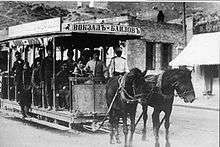Trams in Baku
 | |||||||||
| Operation | |||||||||
|---|---|---|---|---|---|---|---|---|---|
| Locale | Baku, Azerbaijan | ||||||||
| |||||||||
| |||||||||
| |||||||||
The Baku tramway network was a network of tramways forming part of the public transport system in Baku, now the capital city of Azerbaijan, between 1889 and 2004.
History
Early tramways
The first tramway in Baku was a cable powered line, opened in 1887. It was used for passenger traffic and was later named "Čornogorods′ka". On 7 April (19 April) 1889, a horsecar line was opened.[1] The owner of that line took over the Čornogorods′ka line, and converted it to horsecar operation.

Some five months later, on 24 September (6 October) 1889, the horsecar tramway was supplemented by a steam tramway.[2] However, the steam tramway did not last very long. Competition from the horsecar tramway made it unprofitable, and it was closed in about 1894 and transformed into another horsecar tramway.
The Baku horsecar tramway was built to 1,524 mm (5 ft) gauge. There were also freight tramways laid between various enterprises around the city.
By the start of the 20th century, the horsecars were already unable to cope with growing volumes of passenger traffic in the oil industry centre of the Russian Empire. In 1903, the City Council received a proposal for the construction of a Baku electric tramway. For the next 20 years, the city bureaucracy created numerous commissions, and developed projects and budgets, until 1922, when the Council began planning the construction of an electric tramway network.
Meanwhile, Baku continued to be served by horsecar trams until the horsecar network was closed on 1 October 1923.[1]
Electric tramway
On 8 February 1924, an electric tramway was opened in Baku. The electric tramway network lasted until January 2004.[3]
In February 2012, the government of Azerbaijan announced that it is planning to restore the tramway in Baku after dismantling it only eight years ago. A new tramway line will be laid along the seaside promenade of Baku Boulevard in central Baku as part of the "Baku White City" development project. Unlike the former tramway network, the new tramway network will be considerably shorter in length and it will not serve within the main road networks of Baku as was the case with the former tramway network; but it will instead run along the seaside promenade thus not clashing with the road traffic.[4]
Lines
As of 1972, the electric tramway network's lines (with destinations in Russian) were as follows:[5]
- № 1 – Больница им. Семашко (Semashko Hospital) — микрорайон №№ 1, 5 (1st and 5th Districts).
- № 2 - Больница им. Семашко (Semashko Hospital) — Мусабеково (Musabekovo).
- № 3 – Баку-пассажирский ж.д. вокзал (Baku Passenger station) — 8-й км (8 km).
- № 4 – Баку-пассажирский ж.д. вокзал (Baku Passenger station) — текстильный комбинат им. Ленина (Lenin Textile Plant).
- № 5 – Больница им. Семашко (Semashko Hospital) — пос. Воровского (Vorovskogo).
- № 10 – Баку-пассажирский ж.д. вокзал (Baku Passenger station) — ул. Инглаба (St. Inglaba).
- № 12а – Баку-пассажирский ж.д. вокзал (Baku Passenger station) — ул. Фабрициуса (St. Fabricius) — больница им. Семашко (Semashko Hospital) — ул. Бакиханова (Bakikhanov street) — пл. Физули (Fizuli place) — ж.д.вокзал (railway station) (circular route).
- № 12б – Баку-пассажирский ж.д. вокзал (Baku Passenger station) — пл. Физули (Fizuli place) — ул. Бакиханова (Bakikhanov street) – больница им. Семашко — ул. Фабрициуса (Fabricìusa street) — ж.д.вокзал (railway station) (circular route).
- № 14 – Баку-пассажирский ж.д. вокзал (Baku Passenger station) — ул. Чапаева (Chapayev street) — ул. Ага Нейматуллы (AGA Nematulla street) — колхозный рынок (Kolhozen Bazar).
By the end of the 1980s, the network's lines (with destinations in Russian) had become:
- № 1 – ст.м. Хатаи (Khatai Metro station) — 1-й микрорайон (1st District).
- № 2 – ж/д Вокзал (railway station) — Кольцо ул. Фабрициус, Инглаб, Чапаева (Fabricìusa, Ìnglaba and Chapayev streets) — Вокзал (railway station) (circular route).
- № 3 – ж/д Вокзал (railway station) — ст. м. Аврора. (Aurora Metro station).
- № 4 – ж/д Вокзал (railway station) — Старые Ахмедлы (Old Ahmedli).
- № 5 – пос. Воровского (Vorovskogo) — Монтинский базар (Montinskij Bazar).
- № 6 – ст.м. Хатаи (Khatai Metro station) — Монтинский базар (Montinskij Bazar).
- № 7 – ж/д Вокзал (railway station) — кольцо Чапаева, Инглаб, Фабрициус (Chapayev, Ìnglaba and Fabricìusa streets) — Вокзал (railway station) (circular route).
As of 2004, the only remaining line was line 6.
See also
References
- 1 2 "8. Баку (конка)" [8. Baku (Horse)]. Горэлектротранс (Electrotrans) website (in Russian). Дмитрий Зиновьев (Dmitry Zinoviev). Archived from the original on 31 January 2013. Retrieved 25 September 2012.
- ↑ "472. Баку (паровой трамвай)" [472. Baku (steam tramway)]. Горэлектротранс (Electrotrans) website (in Russian). Дмитрий Зиновьев (Dmitry Zinoviev). Archived from the original on 31 January 2013. Retrieved 25 September 2012.
- ↑ "9. Баку (трамвай)" [9. Baku (tramway)]. Горэлектротранс (Electrotrans) website (in Russian). Дмитрий Зиновьев (Dmitry Zinoviev). Archived from the original on 31 January 2013. Retrieved 25 September 2012.
- ↑ "Tramvay Bakıya qayıdır" [Trams to return to Baku]. ANS PRESS website (in Azerbaijani). Azad Əliyev (Azad Aliyev). 15 February 2012. Retrieved 27 October 2012.
- ↑ "Бакинский трамвай (Baku tramway)". Наш Баку [Our Baku] website (in Russian). Retrieved 25 September 2012.
External links
![]() Media related to Trams in Baku at Wikimedia Commons
Media related to Trams in Baku at Wikimedia Commons
- Baku database / photo gallery and Baku tram list at Urban Electric Transit – in various languages, including English.